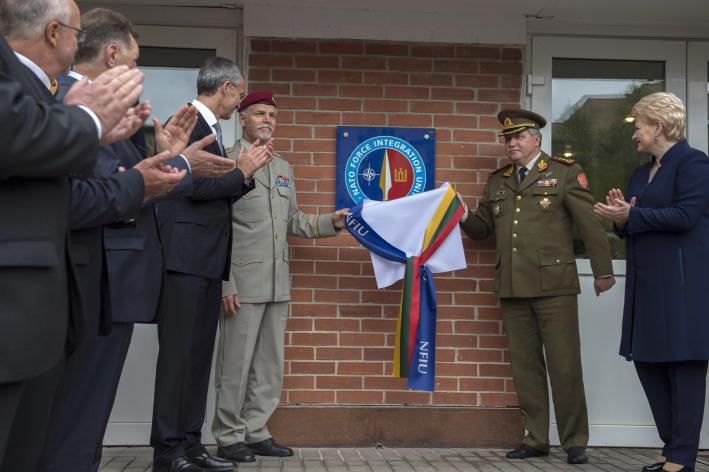NATO Force Integration Unit inaugurated in Vilnius
On September 3rd Director of NATO ENSEC COE Colonel Gintaras Bagdonas has participated in the inauguration ceremony of NATO Force Integration Unit (NFIU) Lithuania, held in Vilnius. NFIU was officially inaugurated by the President of the Republic of Lithuania Dalia Grybauskaitė and NATO Secretary General Jens Stoltenberg.
Activation of the NFIUs is a part of NATO's fundamental adaptation in the face of security challenges from the east and the south.
The Plaque of NFIU on the building of Joint Staff of Lithuanian Armed Forces was revealed by Chairman of the NATO Military Committee general Petr Pavel and Lithuanian Chief of Defence lieutenant general Jonas Vytautas Žukas.
The event was also attended by Prime Minister of Lithuania Algirdas Butkevičius, Minister of National Defence Juozas Olekas, Minister of Foreign Affairs Linas Linkevičius, Commander of Allied Joint Force Command Brunssum General Hans-Lothar Domröse, Commander of the Headquarters Multinational Corps Northeast Lieutenant General Manfred Hofmann, Commander NFIU Lithuania Colonel Jakob Søgård Larsen, Chairs of the Committees for Foreign Affairs, National Security and Defence, European Affairs of the Parliament of the Republic of Lithuania, and other guests.
NATO Force Integration Units are small command and control headquarters with a key mission is to facilitate the rapid deployment of the NATO Very High Readiness Joint Task Force (VJTF) and additional rapid response elements into the region if deemed necessary.
The NFIUs will have a key role in planning, exercising, and assisting potential reinforcements, providing a vital link between national forces and NATO command as well as Force structure.
The NFIU in Lithuania will operate as an intermediate unit facilitating interoperability among national and the region-deployed allied forces. It will also contribute to enhance allied training and exercises, and liaison with NATO’s operational commands.
Staff at the NFIU will cooperate with national forces to identify traffic junctions, key logistical and other necessary infrastructure in the country which will facilitate the quickest possible redeployment of NATO’s response forces into the Baltic region.
Ph. Credits - Alfredas Pliadis

